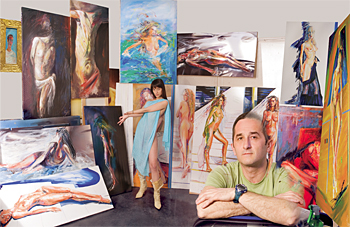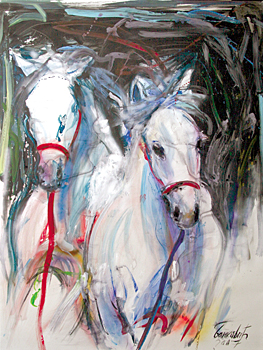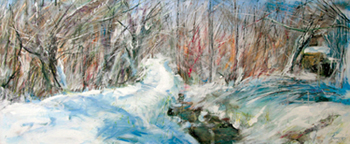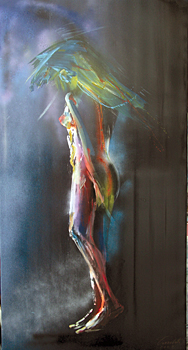The Eye
GORAN BANKOVIĆ, PAINTER, AND HIS BAGGAGE OF ARCHETYPE MEMORIES
An Observer at the Link of Worlds
With deep roots, there under the Vlaška Mountain and the Stolski Kamen, snatched away in one of the numerous migrations to the north, they started being born in the plane of the Serbian Dukedom. Highlanders in their hearts, with the image of the peaceful plane in one eye and the restless mountains in the other. There, in that crossroads of homelands, pensive over itself and the world, this art is born and ascends
By: Brano Pavličić
 Heeeey, from Stol to Odžaci, so many mountains, forests and rivers! So many fords, mills, perplexed paths of destiny! Heeeey, from Stol to Odžaci, so many mountains, forests and rivers! So many fords, mills, perplexed paths of destiny!
Memories are leaking like raindrops leaking from roofs, and each drop, after its fall through space and time, bathes in the color of the earth, the dear one giving birth to life and maintaining all images on the road in the same memory. A little faded, but completely stopped in time which passes with the wind in the leaves, in the grass, in the manes of horses with an almost human face, images of a recognizable world of painting are born, a world at the reach of our hand and eye, but still unreachable to our ability of recognizing.
Near Babušnica, as if has grown from the slope of Vlaška Mountain, the unusual and colossal Stolski Kamen (Table Rock) raises up to the clouds; under it are the deep roots of the Banković family from which they were snatched away in one of the numerous migrations from the south to the north, sometimes before flames and swords, sometimes before the ghosts of hunger and all kinds of diseases always following it. So, after World War II, the Banković family began being born in the Vojvodina plane. Highlanders in their hearts, with the image of the peaceful plane in one eye and the restless mountains in the other.
In the large oil on canvas, a house. With two floors, with a porch with arches from where one can see afar, a kind of house built with love and knowledge, one for all times, the guardian of all sorrows and joys. The house in Stol from which the painting world of Goran Banković never exits. Although born in Odžaci in 1964, his studio at the top of one of the old buildings at the Belgrade Savski Trg, full of completed paintings and only a few started ones, is bursting with traces of mountain remote spots and the village of Stol. Then, traces of the Lužnica and Jerma rivers which have had the asphalt road and the telephone cable for centuries; down them went and up them came news from the world out there, from the anticipated distance, height and depth. Traces on canvases, on the walls like inscriptions or images, like a feeling of anxiety of a painter increased by the noise of the metropolis, thundering of trams, and at nights by the arrivals and departures of trains at the main railway station in Belgrade, an anxiety disappearing only in paintings of mysterious meadows, fields and wheat grounds, in paintings of playful horses with the color of the too strong sun, or with the color dimmed, sometimes ash blue, as if they have dived out of a long ago extinguished field fire only remembered by its color.
HORSES
 It is not only the ash color of the wind in the mane of those horses with an almost human expression, those horses with warm eyes coming from loneliness, fear and uncertainty, which urges you to think. It is also the need to be in constant movement, as long as there is strength and curiosity. Constantly running through space that should be conquered, almost wild, or completely wild, these horses are also the human dream about complete freedom, about the disheveled beauty, the object of our slavish envy and constant need to make them part of our lives and part of our needs. It is not only the ash color of the wind in the mane of those horses with an almost human expression, those horses with warm eyes coming from loneliness, fear and uncertainty, which urges you to think. It is also the need to be in constant movement, as long as there is strength and curiosity. Constantly running through space that should be conquered, almost wild, or completely wild, these horses are also the human dream about complete freedom, about the disheveled beauty, the object of our slavish envy and constant need to make them part of our lives and part of our needs.
And the painter stops them at the moment they are most beautiful, then lets them go down the Pannonian fields, through the forests and snowdrifts of the wildest Carpathians that descend far to the south, only twice cut, as if by a knife, by the Danube and the Nišava, and where they are called Stara Planina, Suva Planina and who knows how else. With a neigh, the herds fly over Banković’s spaces almost as the mythical winged horses, followed by melancholic laments and gilded ballads about the best among them, as well as the best among the riders, remembered by deep nights, sinister mornings, a fast knife and nooses waiting for these thieves, who are not stealing horses, but freedom and human dreams.
THE LANDSCAPE OF THE PLANE
The plane strikes by Odžaci, the rivers interlace then deinterlace into a deep and wide one, the Danube, and the swamps first huddle like the clothes of a poor man when the košava wind blows, then widen up as if they would like to be a sea again, the Pannonian one. All those ambitions of the space found themselves in Banković’s landscape in all their luxury and mysteriousness, with a human trace in each blade of grass and the scent of those wide fields and rivers, which simply strike you with their freshness. There is a goodness in that plane even when it is turbulent, stirred, when it is covered with low clouds and long rains, and when, during their short reign, dry snow storms and northern winds knock with their icy beaks on its misty windows and large wrought gates as a sly guest.
THE LANDSCAPE OF THE MOUNTAIN
 The intimacy of space. It is a row of images, memories of spaces fenced with jealousy, its own views of the world in the distant spots of Suva Planina, views grown out of a raging battle for survival, out of fear of each upcoming day and uncertainty of new times. The specificity of this world was preserved in the frames of almost chamber meadows, narrow paths between them, and everything marked with the simply impossible, both gentle and vicious at the same time, is imprinted forever. The patina in these paintings is in fact human sweat and blood in its other universal meaning, they are the always and repeatedly sowed hopes, calloused fields and palms, the barks of corns a hundred years old. The intimacy of space. It is a row of images, memories of spaces fenced with jealousy, its own views of the world in the distant spots of Suva Planina, views grown out of a raging battle for survival, out of fear of each upcoming day and uncertainty of new times. The specificity of this world was preserved in the frames of almost chamber meadows, narrow paths between them, and everything marked with the simply impossible, both gentle and vicious at the same time, is imprinted forever. The patina in these paintings is in fact human sweat and blood in its other universal meaning, they are the always and repeatedly sowed hopes, calloused fields and palms, the barks of corns a hundred years old.
The one who knows can read destinies of generations from the sharp blades of dry grass, and unravel the heroic and other stories that always provoke sorrowful smiles and a few bitter tears. It is a world fallen asleep in pride, aware of its significance, omnirecognizable, opening its door only to the ones it wants to open. One cannot enter it uninvited, unloved, unknown.
LANDSCAPES OF THE HUMAN SOUL
 A mystery, only an emphasized torso, from nothing into nothing, memory of oneself in all times of complete uncertainty and a shy and carefully kept secret about one’s weakness. An image of a human torn between dreams and reality, with a full consciousness about the transience of shape, but with the need to preserve the seal of a witness. Could one wish for a better witness than the author? A mystery, only an emphasized torso, from nothing into nothing, memory of oneself in all times of complete uncertainty and a shy and carefully kept secret about one’s weakness. An image of a human torn between dreams and reality, with a full consciousness about the transience of shape, but with the need to preserve the seal of a witness. Could one wish for a better witness than the author?
The preoccupation with people and their fate, in numerous almost life-size paintings (surprising, having in mind the size of the studio), deserves a special quest of the observer. Such preoccupation in those paintings with different expressions, from mysteriousness and dimmed color, to a bright palette and almost photographical manner, from ascension to confusion, makes one think about the author. About the man torn between two such different spaces, two heritages, two color palettes, several worlds, about the man punished with curiosity as the obligation of suffering, torn between the image within himself and the image before him.
These canvases have sorrow and refinement, and the painful nakedness in color and expression, in the movement of the alive obsessed with conquering the eye, but there is also crippledness hidden in the need of a human to fascinate only with his appearance, forever.
SELF-PORTRAIT
Immediately above the small table covered with colors (how much each of these tables in each studio in the world can tell about its owner, could be a reason for a separate text) hangs the author’s self-portrait, probably one of his first serious pieces. Different in many ways from the others, except in color, the color of the long forgotten places of fire. With a little color, somehow ashy and washed by many years of rain.
Assumingly carelessly, the layers of color are placed with a wide palette. You see a man, he’s there, everything is in its place, in an unemphasized way, as in some serious joke, and its not; everything is there and yet there is nothing. There is no eye line, yet the eye is there; there is no nose line, yet the nose is there, a bordered space painted with a human, and he is there, the observer is completely certain. Is it some kind of mystery? Yes. Is it an illusion? No.
Besides many writings and photographs on the wall, among which the village of Stol and that unusual Rock of Stol dominate, stands the self-portrait which ages together with his author. Everything is changeable in it, yet it isn’t, it is that painter then and today, it expresses something which cannot be changed in a human, even if one would want it.
And so, high above the tram rails, above the unendurable noise, under the not so clean sky seen through the glass roof of the studio, the man and his self-portrait socialize, create, travel through time.
***
The Path
Goran Branković was born in Odžaci in 1964. He graduated from the Middle School of Arts in Niš and from the Academy of Fine Arts in Sarajevo, in the class of professor Radenko Mišević, while his mentor at postgraduate studies was professor Miodrag Ćorović.
He had more than ten solo exhibitions: in Sarajevo (twice, before the war), then in Belgrade, Herceg Novi, Nikšić...
Among group exhibitions, the most important are the October Salon in Belgrade and the April Salon “Kolegijum Artistikum” in Sarajevo which used to be significant for fine arts, also before the war.
He sowed his paintings in numerous art colonies in the country and abroad. Today he lives and works in Belgrade.
***
View of the Painting
“... In them (Banković’s paintings) one can find ungraspable optical transitions, trembling and emphasized immediateness of the experience, establishing an authentic artistic handwriting.
The real shape is only anticipated. It can be vaguely seen through the contours, the rough, sometimes accidental organization of the surfaces. The meaning of such established narration is placed in an area of different associative reflections. Its ambiguity doesn’t emerge in the direct relation with the seen; it is derived from the subconsciousness, from the irrational layers of the artist’s being.
So, signals coming from the deep spaces of imagination have a significant role in these pieces, those who, by the will of his creative potential, turn into a completed, yet imagined axiom. In brief, Goran Banković mastered all elements of a painting. He achieved pieces with a recognizable narration, signified with a clear style, which makes him one of the significant authors of our new artistic practice.” (Zdravko Vučinić, art critic and gallery owner, about Goran Banković’s paintings)
|
